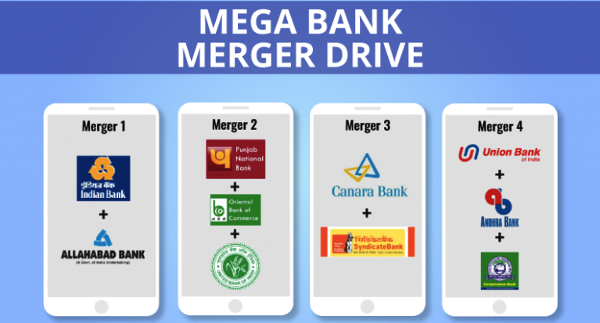The central government’s decision to merge 10 public sector banks (PSBs) to create four bigger entities is likely to create a huge outsourcing opportunity for both Indian and global players in information technology (IT) services in the coming quarters. Including consultancy companies, around Rs 5,000 crore (US$ 7.15 billion) of business could be generated.
To begin with, say sector experts, there would be the immediate integration of various technology stacks. This would create more business for global consulting and IT services entities such as KPMG, PwC, EY, Accenture and IBM, among others. Indian service providers -Infosys, Tata Consultancy Services (TCS), and Wipro, for instance – would also cash in.
“Initially, opportunities will come up in the space of IT consultancy for consolidation of the technology infrastructure. For this initial integration part, a one-time spend of around 0.5 per cent of combined revenue of the merged entities will be required,” says Mr Pareekh Jain, an IT outsourcing advisor and founder of Pareekh Consulting. “Post integration, technology spends of these banks will be higher, as these combined entities will have more resources to invest on digital technologies.”
Typically, in a merger between banks, IT spending on application migration and testing ranges from 0.25 per cent to 0.5 per cent of the new entity’s combined revenue. It might be less in the present case. “The current move has been taken up after careful analysis of synergy in technology stacks. All the to-be-merged entities are using similar versions of the core banking platforms. So, the IT spend will be lesser than in the case of differences,” explained the IT head of a PSB, who wished to not be named.
In fact, while announcing the proposed merger, the government had said that synergy in technology was a criterion in the decision. For instance, United Bank of India, Oriental Bank of Commerce and Punjab National Bank use Infosys’ banking software, Finacle, for their Core Banking Solutions.
Similarly, both Syndicate Bank and Canara Bank use Oracle’s i-flex in this regard. Allahabad Bank and Indian Bank both use TCS’ banking platform, BaNCS. Andhra Bank, Corporation Bank and Union Bank of India all use Finacle.
In some cases, the key IT services vendor is also the same, which would ease the integration process. For instance, IBM is the lead technology vendor for both Canara and Syndicate Bank.
According to global research firm Gartner, the spending on IT services in India is around US$ 15 billion (nearly Rs 1.1 trillion). Of this, 30 per cent comes from the banking, financial services and insurance (BFSI) vertical. Traditionally, global IT services entities like IBM and Accenture have had an upper hand in the Indian BFSI market as compared to Indian counterparts. This is because financial institutions see the former as one-stop destinations, able to provide consulting to application-related services.
“Indian IT firms have never actively pursued the domestic BFSI sector, except the platform business. However, this is certainly going to change, as the size of IT outsourcing contracts is likely to increase with the emergence of bigger banks. If multi-year deals start to touch US$ 100 million, then Indian IT firms will give a tough fight to global players, going ahead,” said Jain of Pareekh Consulting.
Source: IBEF
Image Courtesy: Paisa Bazar
You may also like
-
Trade Connect E-platform For Exports Is Single Window, Fast, Accessible And Transformational: Shri Piyush Goyal
-
Dot Simplifies Approval Processes For Telecom Licenses And Wireless Equipment
-
Coal Production and Supply Trends on Positive Trajectory
-
Union Minister To Release Booklets On Promotion Of Indigenous Species & Conservation Of States Fishes
-
2nd India-Japan Finance Dialogue held in Tokyo on 6th September, 2024
